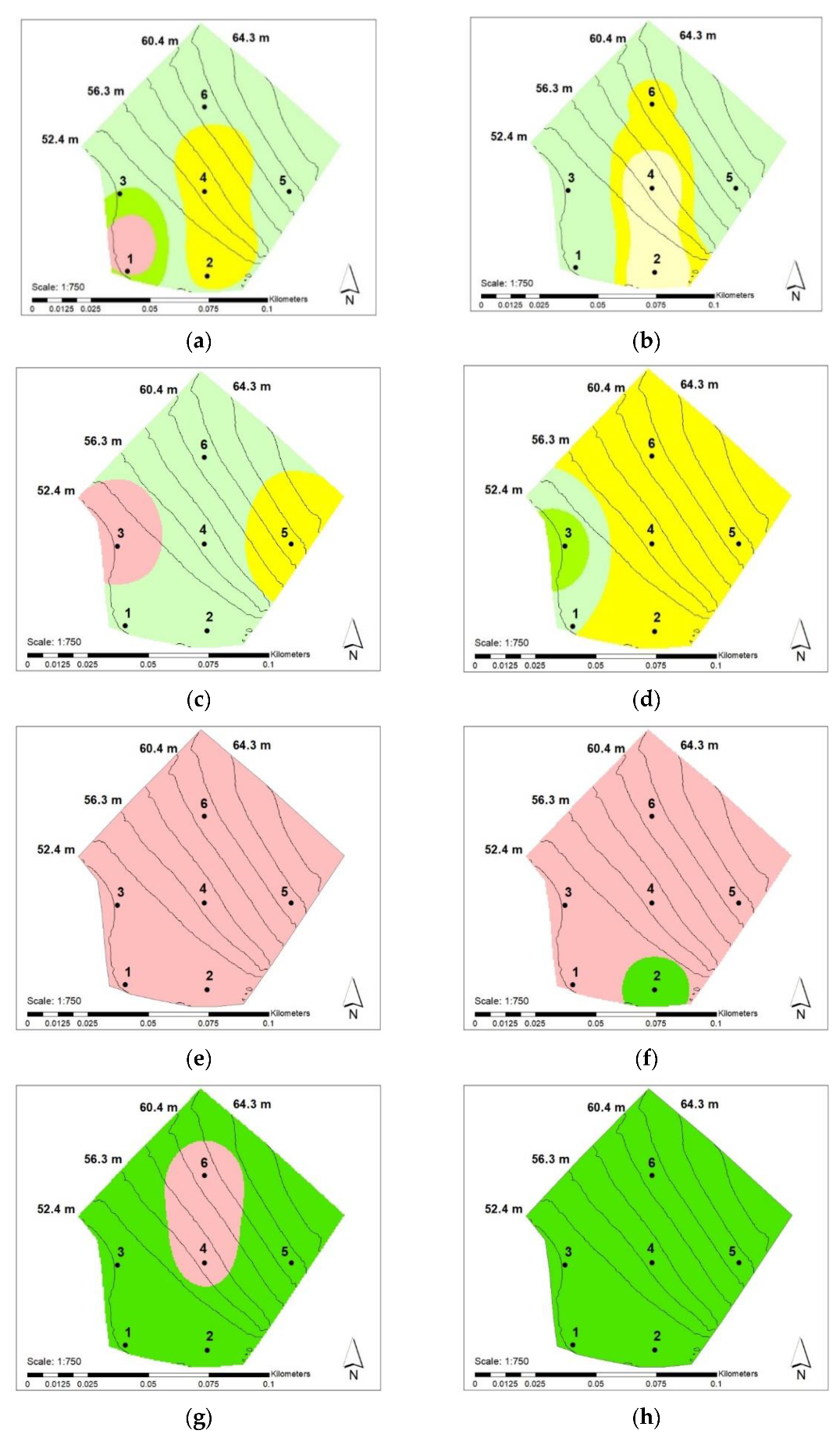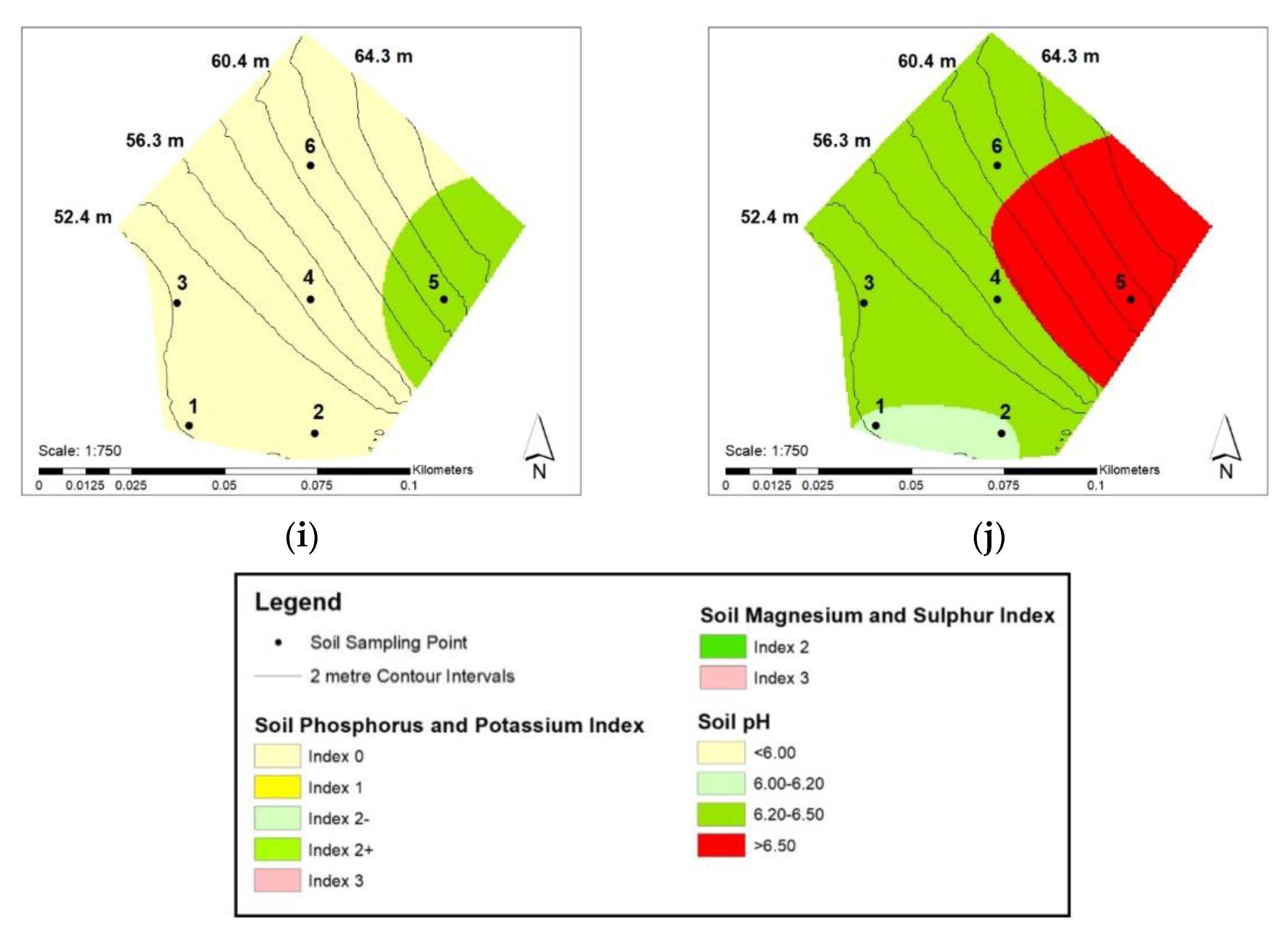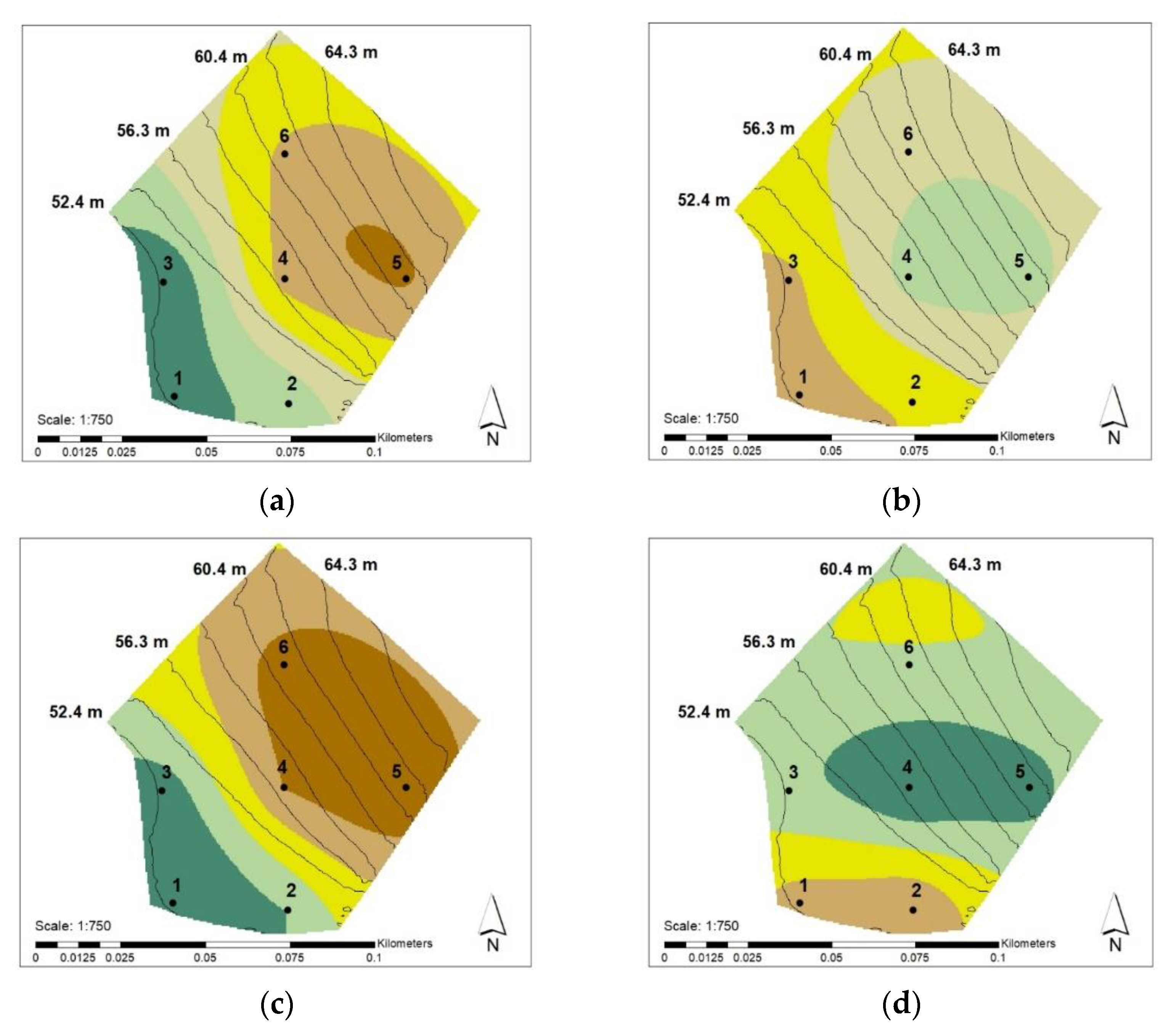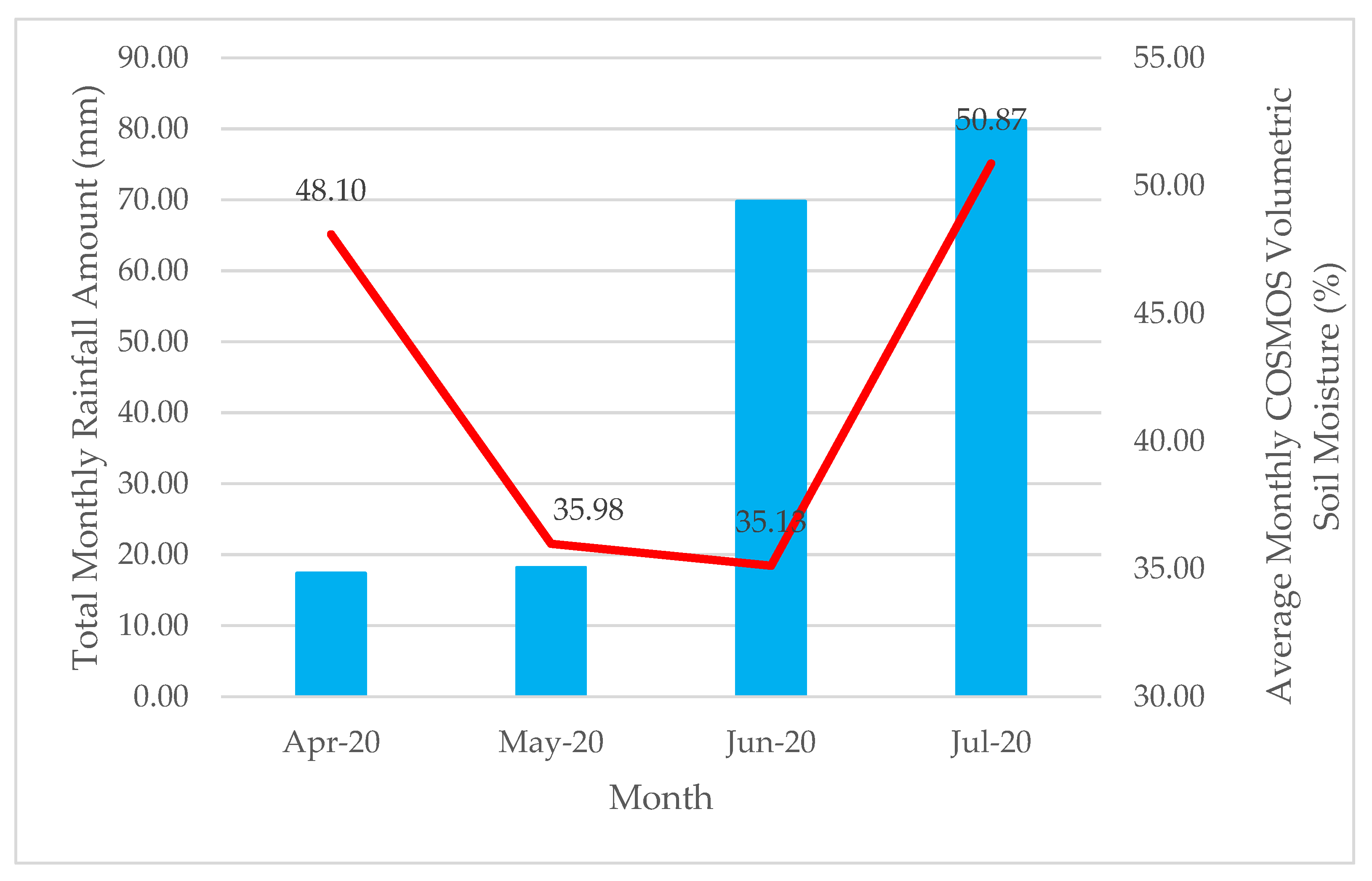Grassland Reseeding: Impact on Soil Surface Nutrient Accumulation and Using LiDAR-Based Image Differencing to Infer Implications for Water Quality
Abstract
:1. Introduction
2. Methods
2.1. Study Catchment
2.2. Assessing the Change in Soil Surface Nutrient Accumulations following Grassland Reseeding
Soil Sampling and GIS-Based Analysis
2.3. Determining Soil Erosion Rates Associated with Grassland Inversion Tillage and Reseeding
2.3.1. Bulk Density Sampling and Sediment Mass Wasting Rates
2.3.2. Nutrient Losses Associated with Soil Erosion
2.3.3. LiDAR-to-LiDAR Comparisons
2.3.4. Calculation of Soil Erosion Rates and Nutrient Accumulation and/or Losses
3. Results
3.1. Effects of Grassland Reseeding on Sub-Field Scale Nutrient Variability
3.2. Calculated Erosion Rates Associated with Grassland Tillage Inversion and Reseeding
3.3. Influences on Soil Erosion Occurrence following Inversion Tillage and Grassland Reseeding
4. Discussion
4.1. Reduction in Soil Surface Nutrient Accumulations following Reseeding
4.2. Sediment and Nutrient Losses Associated with Inversion Tillage and Grassland Reseeding
5. Conclusions
Author Contributions
Funding
Institutional Review Board Statement
Informed Consent Statement
Data Availability Statement
Acknowledgments
Conflicts of Interest
References
- McDonald, N.; Wall, D.; Mellander, P.; Buckley, C.; Shore, M.; Shortle, G.; Leach, S.; Burgess, E.; O’Connell, T.; Jordan, P. Field scale phosphorus balances and legacy soil pressures in mixed-land use catchments. Agric. Ecosyst. Environ. 2019, 274, 14–23. [Google Scholar] [CrossRef]
- Baker, D.B.; Johnson, L.T.; Confesor, R.B.; Crumrine, J.P. Vertical Stratification of Soil Phosphorus as a Concern for Dissolved Phosphorus Runoff in the Lake Erie Basin. J. Environ. Qual. 2017, 46, 1287–1295. [Google Scholar] [CrossRef] [PubMed] [Green Version]
- Wang, Y.T.; Zhang, T.Q.; Hu, Q.C.; Tan, C.S.; Halloran, I.P.O.; Drury, C.F.; Reid, D.K.; Ma, B.L.; Ball-Coelho, B.; Lauzon, J.D.; et al. Estimating Dissolved Reactive Phosphorus Concentration in Surface Runoff Water from Major Ontario Soils. J. Environ. Qual. 2010, 39, 1771–1781. [Google Scholar] [CrossRef] [PubMed]
- Dodd, R.J.; Mcdowell, R.W.; Condron, L.M. Predicting the changes in environmentally and agronomically significant phosphorus forms following the cessation of phosphorus fertilizer applications to grassland. Soil Use Manag. 2012, 28, 135–147. [Google Scholar] [CrossRef]
- Hayes, E.; Higgins, S.; Geris, J.; Nicholl, G.; Mullan, D. The importance of soil phosphorus sub-field scale sampling for understanding and managing surface runoff-based phosphorus losses. CATENA 2022. in review. [Google Scholar]
- Bailey, J.S. Assessing the effectiveness of manure export plus intensive silage cropping for lowering the Olsen-P status of P-enriched grassland. Soil Use Manag. 2015, 31, 438–439. [Google Scholar] [CrossRef]
- Schulte, R.; Melland, A.; Fenton, O.; Herlihy, M.; Richards, K.; Jordan, P. Modelling soil phosphorus decline: Expectations of Water Framework Directive policies. Environ. Sci. Policy 2010, 13, 472–484. [Google Scholar] [CrossRef]
- Wall, D.P.; Jordan, P.; Melland, A.R.; Mellander, P.-E.; Mechan, S.; Shortle, G. Forecasting the decline of excess soil phosphorus in agricultural catchments. Soil Use Manag. 2013, 29, 147–154. [Google Scholar] [CrossRef]
- Bilotta, G.S.; Krueger, T.; Brazier, R.E.; Butler, P.; Freer, J.; Hawkins, J.M.B.; Haygarth, P.M.; Macleod, C.J.A.; Quinton, J.N. Assessing catchment-scale erosion and yields of suspended solids from improved temperate grassland. J. Environ. Monit. 2010, 12, 731–739. [Google Scholar] [CrossRef]
- Evans, R.; Collins, A.L.; Zhang, Y.; Foster, I.D.L.; Boardman, J.; Sint, H.; Lee, M.R.F.; Griffith, B.A. A comparison of conventional and 137Cs-based estimates of soil erosion rates on arable and grassland across lowland England and Wales. J. Earth Sci. Rev. 2017, 173, 49–64. [Google Scholar] [CrossRef]
- Pulley, S.; Collins, A.L. Sediment loss in response to scheduled pasture ploughing and reseeding: The importance of soil moisture content in controlling risk. Soil Tillage Res. 2020, 204, 104746. [Google Scholar] [CrossRef] [PubMed]
- Sharpley, A.N. Soil Mixing to Decrease Surface Stratification of Phosphorus in Manured Soils. J. Environ. Qual. 2003, 32, 1375–1384. [Google Scholar] [CrossRef] [PubMed]
- Watkins, M.; Castlehouse, H.; Hannah, M.; Nash, D. Nitrogen and Phosphorus Changes in Soil and Soil Water after Cultivation. Appl. Environ. Soil Sci. 2012, 2012, 157068. [Google Scholar]
- Hayes, E.; Higgins, S.; Geris, J.; Mullan, D. Using LiDAR derived Digital Terrain Models and field data to quantify riverbank erosion and nutrient loading rates. In Sensing—New Insights into Grassland Science and Practice, Proceedings of the 21st Symposium of the European Grassland Federation, Online, 17–19 May 2021; Astor, T., Dzene, I., Eds.; The Organising Committee of the 21st Symposium of the European Grassland Federation, Universität Kassel, Grassland Science and Renewable Plant Resources: Witzenhausen, Germany, 2021; Volume 26, pp. 196–198. [Google Scholar]
- Bastola, S.; Murphy, C.; Sweeney, J. The role of hydrological modelling uncertainties in climate change impact assessments of Irish river catchments. Adv. Water Resour. 2011, 34, 562–576. [Google Scholar] [CrossRef]
- Cassidy, R.; Thomas, I.A.; Higgins, A.; Bailey, J.S.; Jordan, P. A carrying capacity framework for soil phosphorus and hydrological sensitivity from farm to catchment scales. Sci. Total Environ. 2019, 687, 277–286. [Google Scholar] [CrossRef]
- McCormick, S.; Jordan, C.; Bailey, J.S. Within and between-field spatial variation in soil phosphorus in permanent grassland. Precis. Agric. 2008, 10, 262–276. [Google Scholar] [CrossRef]
- Shi, Z.; Wang, K.; Bailey, J.; Jordan, C.; Higgins, A. Temporal changes in the spatial distributions of some soil properties on a temperate grassland site. Soil Use Manag. 2006, 18, 353–362. [Google Scholar] [CrossRef]
- MAFF (Ministry of Agriculture, Fisheries and Food). The Analysis of Agricultural Materials, 3rd ed.; Reference Book 427; Her Majesty’s Stationary Office: London, UK, 1986.
- Islam, M.M.; Bhuijan, N.I. Evaluation of various extractants for available sulphur in wetland rice (Oryza sativa) soils of Bangladesh. Indian J. Agric. Sci. 1988, 58, 603–606. [Google Scholar]
- Orr, R.J.; Murray, P.J.; Eyles, C.J.; Blackwell, M.S.A.; Cardenas, L.M.; Collins, A.L.; Dungait, J.A.J.; Goulding, K.W.T.; Griffith, B.A.; Gurr, S.J.; et al. The North Wyke Farm Platform: Effect of temperate grassland farming systems on soil moisture contents, runoff and associated water quality dynamics. Eur. J. Soil Sci. 2016, 67, 374–385. [Google Scholar] [CrossRef] [Green Version]
- Webster, R.; Oliver, M.A. Geostatistics for Environmental Scientists, 2nd ed.; Webster, R., Oliver, M.A., Eds.; John Wiley & Sons Ltd.: Chichester, UK, 2007; p. 330. [Google Scholar]
- Cresswell, H.P.; Hamilton, H. Particle Size Analysis. In Soil Physical Measurement and Interpretation for Land Evaluation; McKenzie, N.J., Cresswell, H.P., Coughlan, K.J., Eds.; CSIRO Publishing: Collingwood, Australia, 2002; pp. 224–239. [Google Scholar]
- Thoma, D.P.; Gupta, S.C.; Bauer, M.E.; Kirchoff, C.E. Airborne laser scanning for riverbank erosion assessment. Remote Sens. Environ. 2005, 95, 493–501. [Google Scholar] [CrossRef]
- Kleinman, P.J.A.; Sharpley, A.N.; Withers, P.J.A.; Bergström, L.; Johnson, L.T.; Doody, D.G. Implementing agricultural phosphorus science and management to combat eutrophication. Ambio 2015, 44, 297–310. [Google Scholar] [CrossRef] [PubMed] [Green Version]
- Reinsch, T.; Loges, R.; Kluß, C.; Taube, F. Effect of grassland ploughing and reseeding on CO2 emissions and soil carbon stocks. Agric. Ecosyst. Environ. 2018, 265, 374–383. [Google Scholar] [CrossRef]
- Necpálová, M.; Casey, I.; Humphreys, J. Effect of ploughing and reseeding of permanent grassland on soil N, N leaching and nitrous oxide emissions from a clay-loam soil. Nutr. Cycl. Agroecosyst. 2013, 95, 305–317. [Google Scholar] [CrossRef]
- Linsler, D.; Geisseler, D.; Loges, R.; Taube, F.; Ludwig, B. Temporal dynamics of soil organic matter composition and aggregate distribution in permanent grassland after a single tillage event in a temperate climate. Soil Tillage Res. 2013, 126, 90–99. [Google Scholar] [CrossRef]
- Necpálová, M.; Li, D.; Lanigan, G.; Casey, I.A.; Burchill, W.; Humphreys, J. Changes in soil organic carbon in a clay loam soil following ploughing and reseeding of permanent grassland under temperate moist climatic conditions. Grass Forage Sci. 2014, 69, 611–624. [Google Scholar] [CrossRef]
- Bhogal, A.; Murphy, D.V.; Fortune, S.; Shepherd, M.A.; Hatch, D.J.; Jarvis, S.C.; Gaunt, J.L.; Goulding, K.W.T. Distribution of nitrogen pools in the soil profile of undisturbed and reseeded grasslands. Biol. Fertil. Soils 2000, 30, 356–362. [Google Scholar] [CrossRef]
- Cui, J.; Holden, M. The relationship between soil microbial activity and microbial biomass, soil structure and grassland management. Soil Tillage Res. 2015, 146, 32–38. [Google Scholar] [CrossRef]
- Velthof, G.L.; Hoving, I.E.; Dolfing, J.; Smit, A.; Kuikman, P.J.; Oenema, O. Method and timing of grassland renovation affects herbage yield, nitrate leaching, and nitrous oxide emission in intensively managed grasslands. Nutr. Cycl. Agroecosyst. 2010, 86, 401–412. [Google Scholar] [CrossRef] [Green Version]
- Regan, J.T.; Fenton, O.; Healy, M.G. A review of phosphorus and sediment release from Irish tillage soils, the methods used to quantify losses and the current state of mitigation practice. Biol. Environ. Proc. R. Ir. Acad. 2012, 112B, 157–183. [Google Scholar] [CrossRef]
- Walling, D.E.; Webb, B.W. Suspended load in gravel-bed rivers: UK experience. In Sediment Transport in Gravel-Bed Rivers; Thorne, C.R., Bathurst, J.C., Hey, R.D., Eds.; Wiley: Chichester, UK, 1987; pp. 691–723. [Google Scholar]
- Butler, P.J.; Haygarth, P. Effects of tillage and reseeding on phosphorus transfers from grassland. Soil Use Manag. 2007, 23, 71–81. [Google Scholar] [CrossRef]
- Smith, D.R.; King, K.W.; Williams, M.R. What is causing the harmful algal blooms in Lake Erie? J. Soil Water Conserv. 2015, 70, 27A–29A. [Google Scholar] [CrossRef]







| Identified Zone | P (mg L−1) | Mg (mg L−1) | K (mg L−1) | S (mg L−1) | Total Soil C (%) | Total Soil N (%) |
|---|---|---|---|---|---|---|
| Deposition Zone | 21.5 | 124.0 | 155.0 | 9.7 | 5.6 | 0.5 |
| Erosion Zone | 17.4 | 175.3 | 183.3 | 11.1 | 6.1 | 0.6 |
| Percentage Change in Soil Nutrient Content and Soil pH from 2020 to 2021 | |||||
|---|---|---|---|---|---|
| Sample Point ID | Soil P Content | Soil K Content | Soil Mg Content | Soil S Content | Soil pH |
| 1 | 36.7% decrease (11.7) | 2.9% decrease (5.0) | 0.9% increase (1.0) | 8.9% increase (0.72) | 8.1% increase (0.46) |
| 2 | 30.0% decrease (3.9) | 7.7% decrease (10.0) | 6.6% decrease (7.0) | 4.8% decrease (0.46) | 13.8% increase (0.74) |
| 3 | 11.9% decrease (2.4) | 32.2% decrease (95.0) | 17.3% decrease (23.0) | 9.1% decrease (0.91) | 14.1% increase (0.80) |
| 4 | 52.0% decrease (6.5) | 37.5% decrease (60.0) | 14.2% decrease (21.0) | 18.9% decrease (2.16) | 16.0% increase (0.88) |
| 5 | 5.1% increase (0.9) | 4.6% increase (5.0) | 6.9% decrease (8.0) | 0.8% decrease (0.08) | 14.4% increase (0.90) |
| 6 | 47.7% decrease (10.2) | 24.1% decrease (35.0) | 14.8% increase (17.0) | 25.7% decrease (3.36) | 15.9% increase (0.88) |
| Percentage Change in Soil Total N (%) Content and Soil Total C (%) Content from 2020 to 2021 | ||
|---|---|---|
| Sample ID | Soil Total N (%) Content | Soil Total C (%) Content |
| 1 | 39.1% increase (0.2) | 42.3% increase (2.1) |
| 2 | 27.6% increase (0.1) | 31.1% increase (1.6) |
| 3 | 8.2% increase (0.1) | 54.9% increase (2.5) |
| 4 | 30.5% decrease (0.2) | 29.7% decrease (1.9) |
| 5 | 3.0% decrease (0.2) | 27.2% decrease (1.9) |
| 6 | 18.9% decrease (0.1) | 14.7% decrease (0.9) |
| Identified Zone | Deposition Zone | Erosion Zone |
|---|---|---|
| Volume Change Rates (m3) | 39.1% increase (0.2) | 42.3% increase (2.1) |
| Volume Change Rates (m3 ha−1) | 27.6% increase (0.1) | 31.1% increase (1.6) |
| Deposition/Erosion Rate (cm) | 8.2% increase (0.1) | 54.9% increase (2.5) |
| Deposition/Erosion Rate (cm ha−1) | 30.5% decrease (0.2) | 29.7% decrease (1.9) |
| Mass Wasting Rates of Sediment (kg) | 3.0% decrease (0.2) | 27.2% decrease (1.9) |
| Mass Wasting Rates of Sediment (kg ha−1) | 18.9% decrease (0.1) | 14.7% decrease (0.9) |
| Identified Zone | Deposition Zone | Erosion Zone | Deposition-Adjusted Losses |
|---|---|---|---|
| Soil P Accumulation/Losses (mg) | 3277 | 2984 | −292 |
| Soil P Accumulation/Losses (mg ha−1) | 8855 | 8778 | −76 |
| Soil Mg Accumulation/Losses (mg) | 18,901 | 30,146 | 11,245 |
| Soil Mg Accumulation/Losses (mg ha−1) | 51,071 | 88,661 | 37,590 |
| Soil K Accumulation/Losses (mg) | 23,626 | 31,522 | 7895 |
| Soil K Accumulation/Losses (mg ha−1) | 63,838 | 92,707 | 28,868 |
| Soil S Accumulation/Losses (mg) | 1481 | 1913 | 432 |
| Soil S Accumulation/Losses (mg ha−1) | 4003 | 5628 | 1624 |
| Soil C Accumulation/Losses (mg) | 849 | 1041 | 192 |
| Soil C Accumulation/Losses (mg ha−1) | 2294 | 3064 | 770 |
| Soil N Accumulation/Losses (mg) | 82 | 104 | 22 |
| Soil N Accumulation/Losses (mg ha−1) | 222 | 308 | 86 |
Publisher’s Note: MDPI stays neutral with regard to jurisdictional claims in published maps and institutional affiliations. |
© 2022 by the authors. Licensee MDPI, Basel, Switzerland. This article is an open access article distributed under the terms and conditions of the Creative Commons Attribution (CC BY) license (https://creativecommons.org/licenses/by/4.0/).
Share and Cite
Hayes, E.; Higgins, S.; Geris, J.; Mullan, D. Grassland Reseeding: Impact on Soil Surface Nutrient Accumulation and Using LiDAR-Based Image Differencing to Infer Implications for Water Quality. Agriculture 2022, 12, 1854. https://doi.org/10.3390/agriculture12111854
Hayes E, Higgins S, Geris J, Mullan D. Grassland Reseeding: Impact on Soil Surface Nutrient Accumulation and Using LiDAR-Based Image Differencing to Infer Implications for Water Quality. Agriculture. 2022; 12(11):1854. https://doi.org/10.3390/agriculture12111854
Chicago/Turabian StyleHayes, Emma, Suzanne Higgins, Josie Geris, and Donal Mullan. 2022. "Grassland Reseeding: Impact on Soil Surface Nutrient Accumulation and Using LiDAR-Based Image Differencing to Infer Implications for Water Quality" Agriculture 12, no. 11: 1854. https://doi.org/10.3390/agriculture12111854





